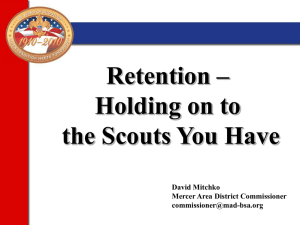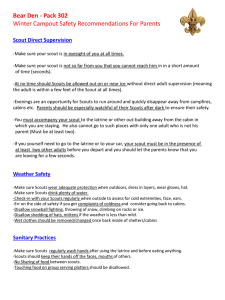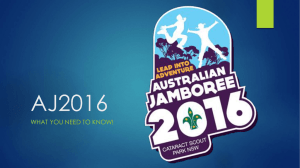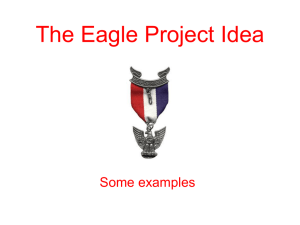Scouts with Disabilities
advertisement
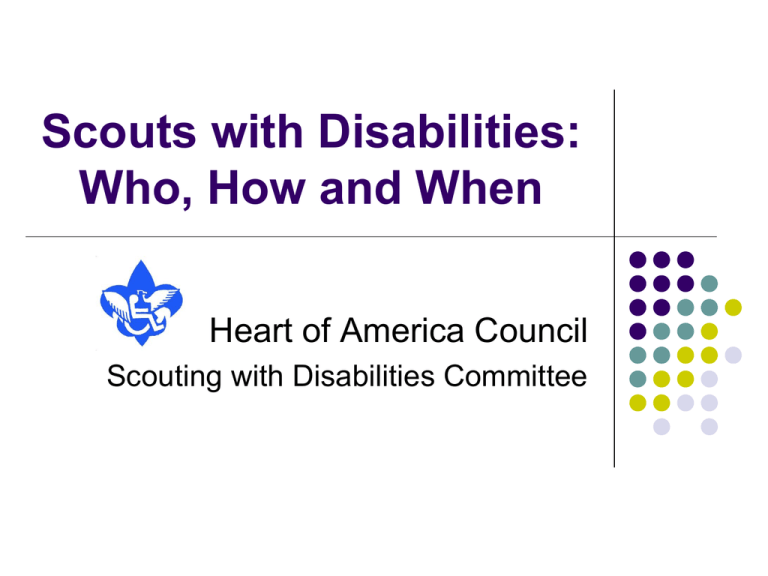
Scouts with Disabilities: Who, How and When Heart of America Council Scouting with Disabilities Committee A Program of Opportunities Our Goal: “The basic premise of Scouting for youth with disabilities is that every boy wants to participate fully and be treated and respected like every other member of the troop.” A Guide to Working with Boy Scouts with Disabilities BSA Inclusion… BSA policy is to treat members with disabilities as much like the other members as possible. Scouts with disabilities should participate in the same program as do their peers. Make some accommodations in advancement requirements if absolutely necessary. Qualified members to be considered for special needs registration? • Youth and adults who are developmentally disabled, or youth with severe physical challenges. • Other considerations are made for those with SEVERE impairments. What is a disability? “A disability must be permanent and so severe that it precludes advancement even at a rate significantly slower than the considered normal.” What is a disability? “A Scout with a permanent physical or mental disability or disability expected to last more than two years or beyond the 18th birthday for Eagle or Varsity Scout, or 21st for Venturer or Sea Scout.” But… “If ranks can be achieved under accommodations already provided in official literature, or with modifications as outlined…the disability probably does not rise to the level required.” But not… • • • Youth with moderate learning disabilities ADD/ADHD Other disorders Why not? • • • Ranks can be earned, just takes a somewhat longer Does not meet criteria Lessons can be taught creatively Examples of conditions, if severe: • • • • • Autism spectrum disorders Blind/sight-impaired Deaf/Hard of hearing Developmental cognitive delay Developmental delay Examples of conditions, if severe (continued): • • • • • Down Syndrome Emotional or behavioral disorder Physically impaired Severely multiple impaired Traumatic Brain Injury Registration of a youth beyond the age of eligibility Over age 11 for Cub Scout Over age 18 for Boy Scout or Varsity Scout Over age 21 for Venturer or Sea Scout Members approved are registered with a disability code. How to register a youth beyond the age of Eligibility: A letter from the parent or guardian. A completed youth membership application. A completed BSA Health and Medical Record form. attesting to the nature of the disability, its severity, and permanent limitations connected with it. How to register a youth beyond the age of Eligibility: • A signed statement from a qualified health professional. • A letter from the unit leader advocating for the registration. Signed medical statement: • For physical disabilities: • Licensed physician • For developmental or cognitive disabilities: • Licensed psychologist or psychiatrist • Neurologist • Other medical professionals related to the disability Registration continued: • Other supporting documentation, such as an Individualized Education plan, Educational Diagnostic Summary, treatment plans are only supporting and not required documents. Decisions for eligibility cannot be made solely on these documents without a medical statement. Registration Procedures: • • • • Have all the documents prepared. Submit to the Council Executive Board. The board may delegate the action to CAC, or other Council operating committee, like Scouts with Disabilities. The decision cannot be made by one individual or one district. Registration Procedures • If granted, the Scout Executive prepares an approval letter and send it to the Scout’s parents or guardian and unit leader or committee chairman. • A copy will remain on file with the registrar as long as the Scout remains registered. • Keep a copy on file at the troop level for each charter. Registered as Special Needs Means • May continue to work on your advancement, including Eagle rank beyond the age of 18, Venturers and Sea Scouts beyond the age of 21. • May earn Eagle palms, Varsity Scout Letter, Awards and Ranks. • Will remain registered as a youth for his scouting career. How to remove the Disability Code • The local council or National Council may receive evidence that the Scout no longer meets the criterion for the required level of severity. • If evidence has been uncovered that the youth was improperly registered. • If the disability code assigned has expired because the Scout has progressed sufficiently to be registered as an adult. What is the next step for the qualifying Scout? A clear and open understanding between the troop leadership and the parents or guardians is necessary. The leaders should know the Scout’s strengths, weaknesses, medications, personal care needs and emergency procedures. The leadership needs to be honest about the support and resources they may need for this youth to be successful. What is the next step for the qualifying Scout? Sit down with the Scoutmaster, Troop Committee Chairman and parents and make an advancement plan. The member is expected to meet the requirements- no more and no less – and do exactly what is stated. “Show or demonstrate” is exactly what they must do; list, in the field, collect, identify, label all must be done as stated. What is the next step for the qualifying Scout? A scout should do his best. He should complete all requirements to the best of his abilities and resources without modifications. Decide if he will require alternative requirements for the lower ranks as well as the Eagle-required merit badges. Applying for alternate requirements for Tenderfoot to 1st Class: The unit leader or troop committee chairman submits to the Council Advancement Committee a written request for alternate requirements and suggestions for those requirements. Supporting letters must accompany the request. What are supporting letters? Unit leader. Parents or guardian. Scout, if possible. Qualified health professional related to the nature of the disability: Physician, neurologist, psychiatrist, psychologist or educational administrator. What must be included in the supporting letters? Describe the disability. Cover the scout’s capabilities, limitations and prognosis. List what requirements cannot be completed as written. See handout. Submit school records such as an IEP, Diagnostic Summary, treatment plans as supporting evidence. What next? The Advancement Committee looks at the supporting letters and tries to make a fair determination. The decision is then recorded and delivered to the Scout and unit leader. Before the first meeting Before a Scout with a disability joins the troop, the Scoutmaster should meet with his adult and youth leaders about expectations from the troop and members. Have permission from the parents to discuss the Scout’s disability and that you are educating the troop. Invite them to teach. Stress the scout is like everyone else and will have a positive impact on the troop. What is the Advancement Plan? The standard is: “Has he done his best?” It is flexible so that he can do the skills as written. It may take longer, but he can do it. Be sure to include the parents/guardians in the process of substitutions since they know their son best. Do you have to register your Scout as special needs? A Scout at any level may qualify for limited flexibility in advancement without being registered as special needs. You must teach to the standards, “Has he done his best?” given extended time, read to or scribed for as described in the IEP. Equal alternatives may be put in place: push a wheelchair in place of hiking, wall push ups, power point presentations in place of speaking. What is the Advancement Plan? Cub Scouts: Permisssion may be given by the Cubmaster and Pack Committee to substitute electives for achievement requirements that are beyond his abilities. What is the Advancement Plan? Cub Scouts: Immediate recognition is important both at den meetings and at the pack level. Recognize how much time, patience and flexibility is required for the scout to succeed. What is the Advancement Plan? Boy Scouts/Varsity Scouts/Venture Scouts: Before applying for alternatives, the Scout must do the very best he can to develop himself to the limit of his abilities and resources. Merit Badges/Awards Boy Scouts/Varsity Scouts/Venture Scouts: No one has the authority to add to or subtract from the requirements of a merit badge or award. A Scout is expected to meet the requirement as stated- no more, no less. There are no substitutions or alternatives permitted except those which are specifically stated in the requirements. Merit Badges/Awards Boy Scouts/Varsity Scouts/Venture Scouts: If they cannot meet the requirement of the merit badge due to their disability, then they need to choose an equivalent alternate. If the alternate involves physical activity, they must be approved my a physician. Applying for alternate requirements for Eagle Required Merit Badges The unit leader or troop committee chairman submits to the Council Advancement Committee the Application for Alternate Eagle Scout Rank Merit Badges. Supporting letters must accompany the request. The process is the same as the lower ranks. Applying for alternate requirements for Eagle Required Merit Badges The Scout does not have to be registered as special needs to complete the Alternate Requirements application. He must complete all requirements before his 18th birthday, 21st if Venture or Sea Scout, if he is not registered as a special needs Scout. Applying for Alternate Requirements for Eagle Scout Rank Required Merit Badges When getting your council signatures on the Eagle application and during the Eagle Board of Review, attach the copy of the approved Application for Alternate Eagle Scout Rank Required Merit Badges with the Eagle application. Limited Time Extensions • • • If a youth is unable to complete his Eagle Scout requirements due to no fault or choice of his own. Examples are health-related incident requiring hospitalization, family emergency, natural disaster, injuries. It is usually unforeseen, recent onset, complication or intensification of an ongoing issue. Process for Time Extensions • • • Complete the Request for Extension of Time to Earn Eagle Scout Rank form. Submit to the Council Advancement Committee Appeals Coordinator. Include the number of months needed to complete the requirements after the 18th birthday, circumstances with evidence that caused the delay. Process for Time Extensions • • • The coordinator will gather evidence and write a position statement to the National Advancement Team and share it with the Scout, parents and unit leader. If the Scout wants to pursue the extension, a packet is sent to the National Advancement Team. A decision is usually made in 2-4 weeks. Handouts/Activities Scout to First Class ideas. Eagle-required merit badge ideas. ADD/ADHD ideas. Sensory issues. Resources Contact the Scouts with Disabilities Committee. Train leaders and Scouts about disabilities. Provide presentations on how to handle Scouts with disabilities. Brainstorm alternatives for lower ranks. Be a part of your advancement team to prepare a successful plan. Review applications to verify qualifications of the disability. Resources Karen Jones | Chairperson, SWD kjones2030@gmail.com H (816)587-3323 | C (816)223-8036 Gordon Corcoran | Senior District Executive BOY SCOUTS OF AMERICA Heart of America Council 10210 Holmes Road Kansas City, Missouri 64131 O 816.569.4941 | C 913.980.3204 Gordon.Corcoran@scouting.org

